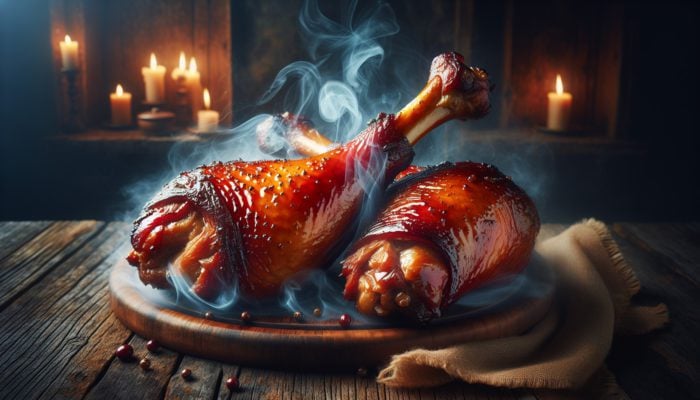Master the Art of Smoking Turkey Legs for an Exceptional American Barbecue Experience
Unveiling the Unique Cultural Significance of Smoking Turkey Legs in American Cuisine

Smoking turkey legs represents more than just a cooking method; it embodies a cherished American culinary tradition that thrives at community events, sporting matches, and family gatherings. The irresistible combination of tender, juicy meat complemented by a rich, smokey aroma creates lasting memories for food lovers. This distinctive culinary practice is intricately tied to the essence of cooking and community, establishing it as a vital component of American culture. Consider these cultural aspects that highlight the significance of smoking turkey legs across the United States:
- Festivals: Events such as state fairs and BBQ festivals feature smoked turkey legs as a staple, showcasing their importance in American cuisine.
- Tailgating: Grilling and smoking turkey legs are essential components of tailgating festivities during the football season, enhancing the celebratory spirit.
- Regional Flavours: Diverse regions across America present unique flavour profiles, from Cajun seasonings in the South to the use of applewood smoke in the Northeast.
- Family Gatherings: At family reunions, smoked turkey legs often take centre stage, reinforcing the values of togetherness and shared experiences.
- Celebrity Chefs: The rising fame of smoked turkey legs has sparked interest among well-known chefs, further elevating their status in gourmet cooking circles.
Essential Equipment for Perfecting Your Turkey Leg Smoking Skills
To create the ultimate smoked turkey leg, having the right gear is crucial. A dependable smoker allows for precise control over both temperature and smoke levels, which are vital for achieving the perfect flavour profile and texture. There is a wide variety of smokers available in Australia, catering to different skill levels and personal preferences. Here’s a curated list of some top smoker brands worth considering:
- Traeger: Famous for their pellet grills, Traeger combines convenience with exceptional flavour delivery.
- Weber: Offers versatile charcoal and gas models, renowned for their effectiveness in backyard smoking.
- Masterbuilt: Known for electric smokers that are easy to use, making them ideal for beginners looking to start their smoking journey.
- Big Green Egg: A classic choice, its ceramic design excels in heat retention and flavour enhancement, making it a favourite among enthusiasts.
- Oklahoma Joe’s: Provides a variety of offset smokers, celebrated for their commitment to traditional smoking techniques.
Expert Steps for Preparing Turkey Legs for a Flawless Smoking Experience
Preparation is a critical phase in the smoking process, significantly impacting the flavour and tenderness of the final product. Properly preparing your turkey legs is essential to ensure they effectively absorb flavours and cook evenly. Follow these key steps to prepare your turkey legs for smoking like a pro:
- Defrost: Always start with thoroughly thawed turkey legs to guarantee even cooking throughout the meat, preventing any cold spots.
- Rinse: Rinse the legs thoroughly under cold running water, then pat them dry using paper towels to eliminate any residues that could affect flavour.
- Trim: Remove excess skin and fat to avoid flare-ups during the cooking process and ensure even cooking.
- Score: Lightly score the skin to facilitate better penetration of smoke and seasoning, enhancing the overall flavour.
- Season: Generously apply your preferred rub or marinade to maximise flavour and depth, setting the stage for an unforgettable dish.
Refining Techniques for Smoking Turkey Legs to Achieve Culinary Mastery

Creating an Impeccable Smoke Ring on Your Turkey Legs
The smoke ring is a signature characteristic of expertly smoked meats, including turkey legs. This visual cue indicates that the meat has been properly smoked, resulting in a succulent and tender product. To achieve this coveted trait, it is essential to understand the science behind smoking. The smoke ring forms as a result of a chemical reaction between the meat and nitrogen dioxide present in wood smoke. To create the perfect smoke ring, maintain low temperatures and select suitable wood types.
Real-world examples show that combining different woods can yield remarkable results. For instance, mixing oak with hickory can create a stunning smoke ring while imparting rich flavours. Additionally, avoid wrapping your turkey legs in foil until the desired smoke ring has formed, as this can impede the necessary reaction. Smoking at around 225°F for a prolonged period is crucial; using a thermometer for precise internal temperature monitoring is highly recommended for optimal results.
Optimal Wood Selections for Smoking Turkey Legs: What You Need to Know
The type of wood you choose plays a pivotal role in crafting the flavour profile of your smoked turkey legs. Different woods impart distinct tastes, making it essential to select the right one to achieve your desired flavour. Some of the best wood options for smoking turkey legs in Australia include:
- Apple: Provides a mild sweetness and fruity flavour that complements poultry beautifully.
- Hickory: Offers a robust, smoky flavour that pairs exceptionally well with turkey.
- Alder: Known for its light and delicate flavour, enhancing the turkey’s natural taste without overpowering it.
- Cherry: Adds a subtle sweetness and a vibrant colour to the meat, elevating its visual appeal.
- Pecan: Similar to hickory but delivers a softer, richer flavour, making it ideal for longer smoking sessions.
When selecting wood, consider both your flavour preferences and what is readily available. Always opt for seasoned wood rather than green wood to avoid undesirable flavours. Experimentation with different combinations can lead to extraordinary results, enabling you to discover your perfect flavour profile for smoked turkey legs.
Maintaining Temperature Control for Perfectly Smoked Turkey Legs

Mastering temperature control is essential for successfully smoking turkey legs. Fluctuations in temperature can lead to uneven cooking, negatively impacting the flavour and texture of your final dish. Precise temperature management ensures that the turkey legs cook consistently and reach the ideal internal temperature of 165°F.
Utilising a digital thermometer can enhance accuracy, allowing you to monitor the internal temperature without repeatedly opening the smoker. Consider these advanced methods for effective temperature control:
- Two-Zone Cooking: Establish areas of indirect and direct heat in your smoker for precise cooking control, helping to avoid overcooking.
- Water Pans: Placing water pans in the smoker stabilises temperatures and adds humidity, which aids in moisture retention during the smoking process.
- Adjusting Vents: Learn to manage airflow through the smoker’s vents, as this significantly influences temperature stability.
- Insulation: In colder weather, wrapping your smoker with insulation helps maintain consistent temperatures, preventing heat loss.
Keeping a detailed log of temperatures throughout the smoking process will assist in refining your techniques for future sessions, ensuring consistently delicious results every time.
Brining Turkey Legs for Maximum Moisture and Rich Flavour
Brining turkey legs is one of the most effective methods to enhance both flavour and moisture retention, resulting in delectable meat. This technique involves soaking the turkey legs in a saltwater solution, which allows the meat to absorb moisture and seasoning, leading to a juicier and more flavoursome final product.
To brine effectively, follow these steps:
- Select a Brine: A basic brine consists of water, salt, and sugar. Enhance this mixture with herbs and spices for added flavour complexity.
- Brining Solution: Use a ratio of 1 cup of salt and 1/2 cup of sugar per gallon of water for a simple brine, adjusting based on your taste preferences.
- Soak Time: Allow the turkey legs to brine for 12 to 24 hours in the refrigerator, ensuring they remain fully submerged for optimal flavour absorption.
- Rinse and Dry: After brining, rinse the legs under cold water to remove excess salt, then pat them dry with paper towels before proceeding to season.
Feel free to explore various flavours in your brine, such as garlic, onion, or citrus peels, to further enrich the depth of flavour in your smoked turkey legs, making each bite a delightful experience.
Timing and Resting Techniques for Perfectly Smoked Turkey Legs
Timing is crucial when smoking turkey legs to achieve optimal flavour and tenderness. Generally, smoking turkey legs for approximately 1.5 to 2 hours at a temperature of 225°F is advisable. However, factors such as the size of the legs and the specific smoker used can influence this duration.
After smoking, allowing the turkey legs to rest is critical for redistributing juices throughout the meat. The resting period should last about 15 to 30 minutes before serving. Consider these key timing and resting techniques:
- Meat Thermometer: Always use a meat thermometer to check for doneness, ensuring the internal temperature reaches 165°F for safe consumption.
- Visual Cues: Observe the skin’s colour and texture; it should appear golden brown and slightly crispy, indicating perfect doneness.
- Foil Wrap: If concerned about the legs cooling down, loosely wrap them in foil during the resting period to help retain warmth.
- Serve Immediately: For the best culinary experience, serve the turkey legs right after resting to enjoy optimal flavour and texture, making them irresistible to guests.
Understanding timing and resting techniques is essential for perfecting your smoking methods, ensuring that every bite of your turkey leg is juicy, flavourful, and thoroughly satisfying.
Creating Unique Flavour Profiles and Mastering Seasoning Techniques
How to Develop a Distinct Flavour Profile for Your Smoked Turkey Legs
Crafting a unique flavour profile for your smoked turkey legs can set your dish apart and leave a lasting culinary impression on your guests. The key lies in experimenting with various flavour combinations that enhance the turkey’s natural taste while adding depth and complexity.
To begin developing your unique flavour profile, consider these exciting combinations:
- Sweet and Spicy: Combine brown sugar, cayenne pepper, and paprika for a delightful balance of sweetness and heat that tantalises the taste buds.
- Citrus Herb: Incorporate lemon zest, thyme, and rosemary to brighten and elevate the flavour of the turkey, making it more refreshing.
- Garlic and Pepper: A blend of garlic powder, black pepper, and onion powder can create a savoury base that complements the meat beautifully.
- Smoky BBQ: Mix smoked paprika, chili powder, and brown sugar for a classic barbecue flavour that pleases the crowd.
When experimenting, document the ratios and ingredients used meticulously. Keeping track of your methods allows you to refine your techniques and replicate successful flavour profiles in future smoking sessions, helping you achieve a distinctive taste that resonates with your style and preferences.
Choosing Between Dry Rubs and Marinades for Your Turkey Legs
Deciding between dry rubs and marinades for turkey legs can significantly influence both flavour and texture. Each method has its advantages, depending on the desired outcome and your cooking style.
Dry rubs typically consist of spice blends applied directly to the meat’s surface, providing an intense burst of flavour and creating a beautifully caramelised crust during the smoking process. In contrast, marinades are liquid mixtures often containing acidic components, such as vinegar or citrus juice, which can tenderise the meat while infusing it with flavour.
Key differences between dry rubs and marinades include:
- Flavor Intensity: Dry rubs generally impart more intense flavours on the surface, while marinades penetrate deeper for a more uniform taste throughout the meat.
- Texture: Rubs contribute to a crispy outer layer, while marinades enhance tenderness in the meat, creating a juicy experience.
- Preparation Time: Rubs can be applied just before cooking, while marinades require longer soaking times for effective flavour infusion.
- Versatility: Dry rubs are often more adaptable and can be customised based on personal preferences and available spices.
Ultimately, the choice between dry rubs and marinades depends on personal preference and the specific flavour profile you aim to achieve in your smoked turkey legs, allowing for creativity in your cooking.
Injecting Flavour into Turkey Legs: A Game-Changer for Enhanced Taste
Injecting flavour into turkey legs is an effective technique to elevate taste and ensure even distribution of spices throughout the meat. This method allows for deep flavour penetration without the need for extended marination times. Using an injection marinade—a liquid blend of spices, broth, and fats—can significantly enhance the overall flavour profile.
To effectively inject flavours, follow these steps:
- Select Your Marinade: Choose a flavourful injection solution, such as a mixture of chicken broth, melted butter, and fresh herbs to create a rich taste.
- Use the Right Injector: A high-quality meat injector with a thin needle is essential for even distribution of the marinade throughout the meat.
- Inject Properly: Insert the needle into various sections of the leg, injecting small amounts of marinade at different points to avoid over-saturation in any one area.
- Rest After Injecting: Allow the turkey legs to rest for at least 30 minutes before smoking; this helps the flavours meld and settle effectively.
Injecting not only enhances flavour but can also help maintain moisture during the smoking process, ensuring each bite of turkey leg is juicy, tender, and bursting with taste.
Achieving a Perfect Balance Between Sweet and Savoury Flavours in Your Turkey Legs
Striking the ideal balance between sweet and savoury flavours is essential for crafting mouthwatering smoked turkey legs. The interplay of these elements can elevate your dish, ensuring a multi-dimensional taste experience that delights the palate.
To effectively balance sweet and savoury flavours, consider these seasoning techniques:
- Combine Ingredients: Use combinations such as maple syrup with soy sauce or brown sugar with garlic to create a harmonious blend of flavours that complement each other.
- Experiment with Acidity: Adding citrus or vinegar can cut through sweetness and enhance the overall flavour balance, making it more complex.
- Layer Flavours: Apply different flavour layers by using a dry rub followed by a glaze during the final stages of smoking to enhance depth.
- Taste Test: Continuously taste your mixtures as you create them, allowing for adjustments based on your preference and the desired outcome.
Balancing flavours is an art that may take time to master. Experimenting with various combinations will help you discover what works best for your palate, allowing you to create signature flavours that will captivate your guests and leave them wanting more.
Utilising Herbs and Spices to Enhance the Depth of Flavour
Incorporating herbs and spices into your seasoning blend can add depth and complexity to smoked turkey legs. The right combinations can elevate the overall flavour experience, introducing unique characteristics to your dish that will impress anyone who tries it.
Consider these techniques for effectively utilising herbs and spices:
- Classical Pairings: Combine thyme, rosemary, and sage to create a traditional poultry seasoning that enhances the natural flavours of the turkey.
- Regional Influences: Incorporate spices like paprika and cumin for a Southwestern flair, or dill and lemon for a fresh, vibrant taste that livens up the dish.
- Fresh vs. Dried: Fresh herbs provide vibrancy and brightness, while dried herbs typically have a more concentrated flavour, making them ideal for rubs and marinades.
- Infusions: Create herb-infused oils or butters to serve as a base for injections or marinades, enhancing the overall flavour profile.
By thoughtfully selecting and combining herbs and spices, you can craft a flavour profile that delivers depth, intrigue, and enjoyment in every bite of your smoked turkey legs, making your dish memorable for all who partake.
Determining Cooking Times and Techniques for Perfectly Smoked Turkey Legs
How Long Should You Smoke Turkey Legs for Optimal Results?
Determining the ideal smoking time for turkey legs is essential for achieving optimal results in both flavour and tenderness. Typically, turkey legs should be smoked for approximately 1.5 to 2 hours at a temperature of around 225°F. However, various factors can influence this timing, including the size of the legs and the specific type of smoker being used.
To ensure perfectly cooked turkey legs, consider these factors:
- Leg Size: Larger legs may require additional smoking time, while smaller legs might cook more quickly, so adjust accordingly.
- Smoker Type: Different smokers retain heat differently; adjusting for your specific equipment ensures accuracy in cooking.
- Internal Temperature: Always use a meat thermometer to confirm that the internal temperature has reached 165°F for food safety and optimal flavour.
- Weather Conditions: Cold or windy weather can impact cooking times, so adjustments may be necessary based on external conditions.
Keeping a close watch on the temperature and utilising a reliable thermometer will help you determine the optimal smoking time for your turkey legs, ensuring they are cooked through while remaining juicy and full of flavour.
Low and Slow vs. Hot and Fast: Choosing the Right Smoking Method for Your Needs
The smoking technique you select for turkey legs can greatly influence both the flavour and texture of the final product. The two primary methods are “low and slow” and “hot and fast.” Each offers distinct advantages, depending on your desired outcome and the time you have available.
The “low and slow” method involves cooking at lower temperatures (around 225°F) for extended periods. This approach allows the meat to absorb optimal smoke flavour while rendering fat and collagen, resulting in tender, juicy legs that are bursting with flavour. This technique is ideal for flavour development and is a staple in traditional smoking practices.
Conversely, the “hot and fast” method entails cooking at higher temperatures (around 300°F) for shorter durations. This method can yield quicker results and a crispy outer skin, but it may not provide the same depth of smokiness and tenderness as the low and slow approach.
Consider these factors when selecting your smoking method:
- Time Constraints: Opt for hot and fast for quick meals; choose low and slow for leisurely smoking sessions that produce rich flavours.
- Flavour Preference: If deep smoke flavour is desired, low and slow is the best choice for a satisfying culinary experience.
- Texture Goals: For crispy skin, hot and fast may be ideal, but be cautious of potential dryness if not monitored properly.
- Event Type: For gatherings or special occasions, low and slow can impress with its complex flavours and tender texture that everyone will enjoy.
Choosing the right method will depend on your priorities and the specific results you want to achieve with your smoked turkey legs, ensuring a delicious outcome every time.
How to Monitor and Adjust During the Smoking Process for Perfect Results
Active monitoring throughout the smoking process is crucial for achieving perfectly smoked turkey legs. This involves closely observing temperature, smoke levels, and moisture to ensure optimal results that please the palate.
To monitor and adjust effectively, consider these strategies:
- Use a Meat Thermometer: A reliable digital thermometer will allow you to check the internal temperature without frequently opening the smoker, preserving heat.
- Observe Smoke Production: Ensure a steady flow of smoke; too little smoke could indicate undercooked meat, while excessive smoke may lead to bitter flavours that detract from the dish.
- Check for Moisture: Keep an eye on water pans and refill as necessary to maintain humidity during the smoking process, preventing dryness.
- Adjust Vents: Learn to manipulate the smoker’s vents to control airflow and temperature, ensuring consistent heat throughout the cooking process.
Recognising signs that your turkey legs are done, such as a beautiful golden-brown colour and an internal temperature reaching 165°F, will help ensure that you serve perfectly smoked turkey legs every time, impressing your guests with your culinary skills.
Research-Based Techniques for Enhancing Your Smoking Experience
How to Elevate Flavour Through Advanced Smoking Techniques
Advanced smoking techniques have shown considerable promise in enhancing the flavour of turkey legs, leading to exceptionally delicious outcomes that delight the senses. Implementing methods such as brining, injecting, and experimenting with wood types can yield remarkable improvements in flavour and texture.
Research indicates that brining not only boosts flavour but also increases moisture retention in the meat. Studies have shown that brined turkey legs can retain up to 25% more moisture than their non-brined counterparts, resulting in juicier, more flavourful meat that is sure to impress.
Real-world applications of flavour enhancement techniques include:
- Injecting marinades rich in herbs and spices for deep flavour penetration that ensures every bite is packed with taste.
- Experimenting with various wood types to discover unique flavour profiles that suit your personal palate.
- Adjusting cooking temperatures and times to optimise flavour development through the Maillard reaction, which creates that sought-after caramelisation.
- Combining dry rubs with marinades for a layered flavour experience that tantalises the taste buds.
By applying these advanced techniques, you can elevate your smoked turkey legs to restaurant-quality levels, impressing family and friends with every delicious bite and making your culinary creations unforgettable.
Improving Texture with Effective Smoking Methods
The texture of smoked turkey legs can be significantly enhanced through specific smoking methods and techniques. A crucial aspect is ensuring that the meat remains moist and tender throughout the cooking process, which can be achieved through several key practices.
Research emphasises that cooking turkey legs low and slow effectively breaks down tough connective tissues, resulting in a more tender texture that melts in your mouth. Additionally, incorporating moisture-rich techniques, such as brining and using water pans, can prevent dryness and promote juiciness in the final product.
Here are actionable steps for achieving the perfect texture:
- Brine the Legs: Boost moisture and tenderness through the brining process, enhancing the overall flavour.
- Monitor Internal Temperatures: Keep a close eye to prevent overcooking, which can lead to dryness and an unpleasant texture.
- Utilise a Two-Zone Cooking Method: Set up controlled heat zones for different cooking stages, allowing for perfect finishing options.
- Allow for Resting Periods: Enable juices to redistribute post-smoking, resulting in a juicy and flavourful bite every time.
By focusing on these techniques, you can significantly improve the texture of your smoked turkey legs, ensuring they are both juicy and tender, providing a satisfying culinary experience.
Health Benefits Associated with Smoked Turkey Legs
When prepared correctly, smoked turkey legs can offer numerous health benefits, making them an excellent addition to a balanced diet. Turkey is a lean protein source that provides essential nutrients while being lower in fat compared to other meats, making it a healthier choice overall.
Studies have indicated that smoked turkey legs can fit into a healthy eating plan, particularly when mindful cooking techniques are employed. Smoking enhances flavour without necessitating excessive oils or fats, allowing you to enjoy rich flavours in a healthier way.
Consider the following health benefits of smoked turkey legs:
- High Protein Content: Turkey is an excellent source of protein, essential for muscle development and overall health, making it a great option for active individuals.
- Lower Fat Content: Compared to other meats, turkey legs provide a satisfying option with significantly less saturated fat, promoting better health.
- Nutrient-Rich: Turkey is packed with important vitamins and minerals, such as B vitamins and selenium, contributing to overall wellness.
- Reduced Additives: Smoking at home allows you to control the ingredients used, avoiding preservatives and additives found in processed meats.
Being mindful of preparation methods, such as brining and seasoning, can further enhance health benefits while maintaining delicious flavours, making smoked turkey legs a viable option for health-conscious consumers looking for tasty choices.
Maximising Enjoyment of Your Smoked Turkey Legs
Choosing the Best Accompaniments for Smoked Turkey Legs
Selecting the right sides and sauces to complement smoked turkey legs can elevate the overall dining experience to new heights. Thoughtful pairings can enhance the flavours of the turkey while creating a balanced and satisfying meal.
Some of the best accompaniments include:
- Classic BBQ Sauce: A tangy or sweet barbecue sauce complements the smokiness of the turkey legs, enhancing the overall flavour profile.
- Coleslaw: The crunch and acidity of coleslaw provide a refreshing contrast to the richness of the meat, balancing the dish beautifully.
- Potato Salad: A creamy potato salad pairs well with smoky flavours, adding heartiness and satisfaction to the meal.
- Grilled Vegetables: Seasoned grilled veggies add colour, texture, and flavour balance to your plate, making it visually appealing.
When selecting accompaniments, consider the flavour profile of your smoked turkey legs. For instance, if you’ve used a sweet rub, pairing it with a tangy sauce can effectively balance flavours, creating a harmonious dining experience that your guests will love.
Enhancing Presentation Techniques for Your Smoked Turkey Legs
Presentation can transform your smoked turkey legs from ordinary to extraordinary. An appealing plate not only enhances the overall dining experience but also makes your dish visually inviting and appetising.
Consider these tips for creating an attractive presentation:
- Use Colour: Incorporate colourful side dishes or garnishes, such as fresh herbs or citrus slices, to brighten the plate and make it visually appealing.
- Plating Techniques: Serve the turkey leg on a rustic wooden board or slate for a charming, natural appeal that enhances the overall look.
- Garnish: Sprinkle chopped herbs over the turkey legs for a fresh touch that adds colour and enhances presentation.
- Serve with Sauce: Offer dipping sauces in small bowls alongside the turkey legs for added visual interest and flavour enhancement.
Thoughtful presentation not only showcases your culinary skills but also enhances the enjoyment of your smoked turkey legs, making them even more enticing for guests who appreciate a well-prepared meal.
Best Practices for Storing and Reheating Smoked Turkey Legs
Proper storage and reheating techniques are crucial for enjoying leftover smoked turkey legs. Following best practices will help maintain their quality and flavour long after the initial cooking process.
To store smoked turkey legs effectively:
- Cool Down: Allow the turkey legs to cool to room temperature before storing them to prevent condensation from affecting quality.
- Wrap Well: Use airtight containers or wrap tightly in aluminium foil or plastic wrap to prevent moisture loss and preserve flavour.
- Refrigeration: Store in the refrigerator for up to 3-4 days, or freeze for longer preservation to maintain freshness.
- Labeling: Always label your storage containers with the date to keep track of freshness and avoid waste.
When reheating, avoid the microwave, as this can dry out the meat. Instead, reheat in the oven at a low temperature (around 250°F) until warmed through, ensuring the legs remain juicy and flavourful, just as they were when first smoked.
Ideal Serving Temperature and Timing for Smoked Turkey Legs
Understanding the optimal serving temperature and timing for smoked turkey legs is essential for a memorable dining experience. Turkey legs should be served hot, ideally at around 165°F, to ensure they are safe and enjoyable for consumption.
To ensure the best flavour and texture, consider these tips:
- Thermometer Check: Always confirm that the internal temperature has reached the desired level for safe consumption.
- Timing: Serve immediately after resting to provide the best texture and flavour, making the dish more appealing to your guests.
- Warm Plates: Pre-warm your serving plates to help maintain the temperature of the turkey legs, ensuring they remain hot and enjoyable.
- Presentation: Plan your serving setup in advance to ensure a smooth transition from cooking to serving, making the experience enjoyable for everyone.
By focusing on proper serving techniques, you’ll enhance the overall experience, ensuring that every guest enjoys delicious, perfectly smoked turkey legs that are sure to impress.
Troubleshooting Common Issues When Smoking Turkey Legs
How to Address Uneven Cooking in Smoked Turkey Legs
Uneven cooking can detract from the enjoyment of smoked turkey legs. Identifying and resolving the causes of uneven cooking is essential for achieving consistently excellent results. Factors such as meat size, smoker temperature, and airflow can contribute to uneven cooking, leading to frustrating outcomes.
To troubleshoot uneven cooking issues, apply these techniques:
- Choose Uniform Legs: Opt for turkey legs that are similar in size to ensure even cooking across all pieces, preventing hotspots.
- Rotate the Legs: If using a vertical smoker, rotate the legs halfway through the smoking process for even exposure to heat, ensuring they cook uniformly.
- Check Hot Spots: Familiarise yourself with your smoker’s hot and cold spots and adjust leg placement accordingly to achieve more consistent results.
- Monitor Temperature: Use a digital thermometer to check multiple legs to ensure they each reach the desired internal temperature for safe consumption.
By implementing these adjustments, you can significantly improve the consistency of your smoking results, delivering perfectly cooked turkey legs every time, much to the delight of your family and friends.
What Steps Should You Take If Your Turkey Legs Turn Out Too Dry?
Dry turkey legs can be a frustrating outcome, often stemming from overcooking or insufficient moisture during the smoking process. Fortunately, there are strategies to salvage dry turkey legs and prevent this issue in the future, ensuring each bite remains enjoyable.
To keep your turkey legs moist and flavourful, consider these solutions:
- Injection: Use a flavourful broth or marinade injection prior to smoking to enhance moisture retention and overall taste.
- Brining: Incorporate a brining process before smoking to infuse moisture and flavour deeply within the meat.
- Wrap in Foil: If you notice the legs drying during cooking, loosely wrap them in foil to trap moisture and prevent further drying.
- Serve with Sauce: Pair dry turkey legs with a flavourful sauce to add moisture and enhance flavour, creating a more enjoyable dining experience.
Taking these proactive measures not only helps to salvage dry turkey legs but also ensures they remain juicy and succulent for future smoking sessions, allowing you to impress your guests with your culinary prowess.
Managing Smoke Flavour Intensity in Your Turkey Legs
Controlling the intensity of smoke flavour is critical for achieving the desired taste profile in your smoked turkey legs. Too much smoke can result in bitterness, while too little may leave the meat lacking in flavour and complexity.
To effectively manage smoke flavour, consider these techniques:
- Wood Selection: Choose milder woods, such as apple or cherry, for subtler flavours, or opt for hickory for a more pronounced smokiness, depending on your preference.
- Adjusting Smoke Time: Limit the duration of time the turkey legs are exposed to smoke during the cooking process to prevent overwhelming smoke flavours.
- Vent Control: Open or close vents on your smoker to manage airflow and influence smoke intensity, ensuring a balanced flavour.
- Taste Testing: Continuously sample during the smoking process to gauge flavour development and make adjustments as necessary for the perfect balance.
By implementing these strategies, you can refine the smoke flavour intensity in your turkey legs, achieving a balanced and enjoyable culinary experience that will impress anyone who tries your dish.
Frequently Asked Questions About Smoking Turkey Legs
What is the typical smoking time for turkey legs?
Typically, it takes about 1.5 to 2 hours to smoke turkey legs at a temperature of 225°F. Factors like leg size and smoker type can influence this time, so always monitor closely.
Which wood is best for smoking turkey legs?
Popular woods for smoking turkey legs include apple, hickory, cherry, and pecan, each imparting unique flavours. Experimenting with combinations can yield delicious and distinct results.
Should I brine turkey legs before smoking them?
Yes, brining turkey legs prior to smoking enhances moisture retention and flavour, resulting in juicier and more delicious meat that everyone will enjoy.
What internal temperature should turkey legs reach when smoked?
Turkey legs should reach an internal temperature of 165°F for safe consumption, ensuring they are fully cooked and enjoyable.
Can I use a gas grill to smoke turkey legs?
Yes, a gas grill can be effectively used for smoking turkey legs by utilising a smoker box or wrapping wood chips in aluminium foil to create smoke.
Is it better to use a dry rub or a marinade?
Both methods have their benefits; dry rubs create a flavourful crust, while marinades penetrate deeper for a more uniform taste. Your choice ultimately depends on personal preference and desired outcomes.
How can I ensure even cooking of turkey legs?
To achieve even cooking, choose legs of similar size, rotate them during smoking, and monitor temperatures with a digital thermometer to ensure uniform results.
What should I do if my turkey legs are dry?
If turkey legs turn out dry, consider injecting them with a flavourful broth or sauce, or serve with a moist dipping sauce to enhance the flavour and overall experience.
How can I enhance the flavour of smoked turkey legs?
You can enhance flavour by using brines, injections, or experimenting with various wood types and seasoning blends to create your unique flavour profile that captivates the palate.
What are the best side dishes for smoked turkey legs?
Great accompaniments for smoked turkey legs include classic BBQ sauce, coleslaw, potato salad, and grilled vegetables for a balanced meal that complements the rich flavours.
Connect with us on Facebook!
The Article Advanced Techniques for Smoking Turkey Legs: US Mastery appeared first on https://pitmastersarsenal.com
The Article Smoking Turkey Legs: Master Advanced Techniques in the US Was Found On https://limitsofstrategy.com



